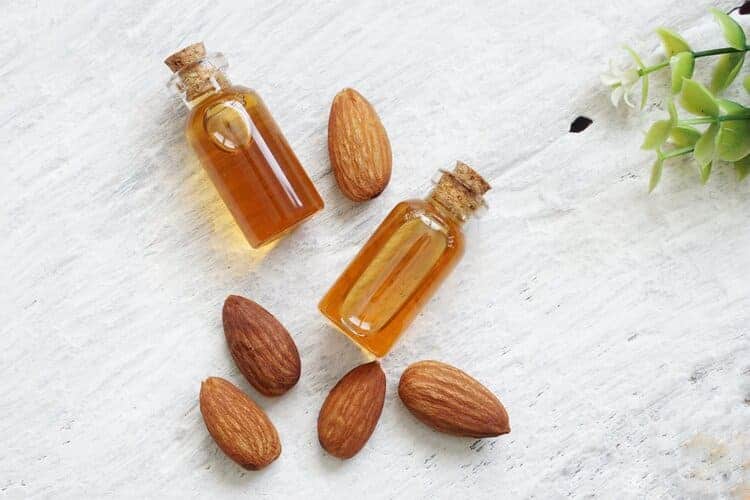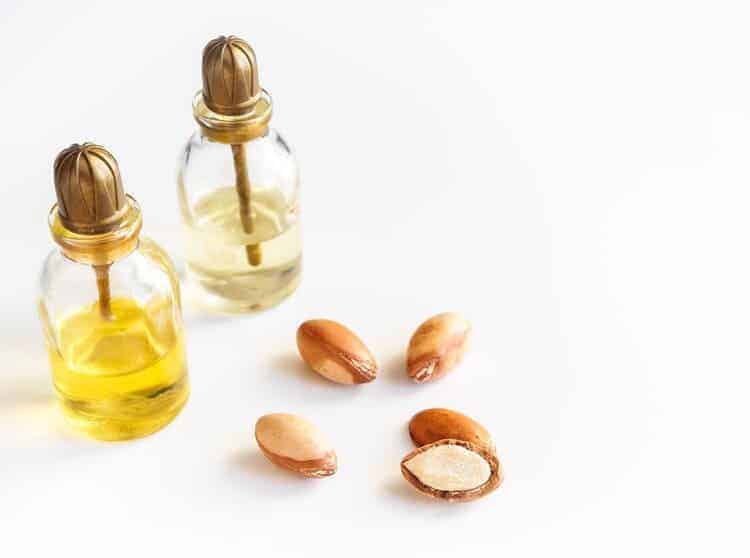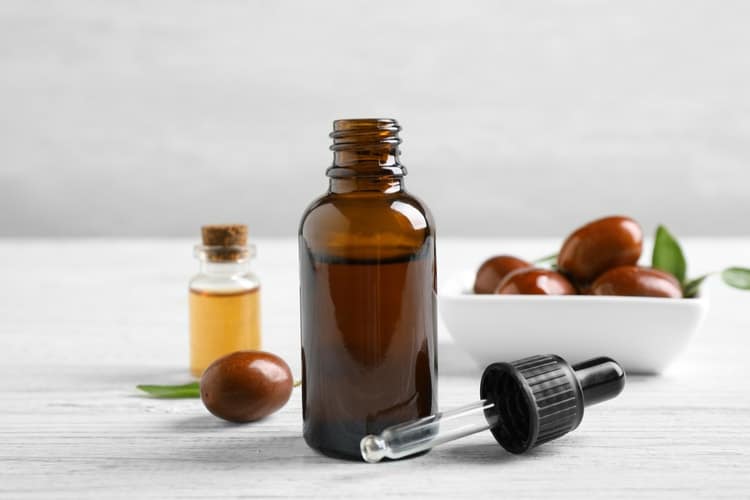
Is your skin dry, cracked, itchy, inflamed, aging or all of the above? Is your skin crying out for more suppleness, softness and moisture? Then this guide on carrier oils for dry skin will help you find the best one for your needs, as well as learn how to use it effectively (because there is actually a wrong way to use oils)!
But before we get into the nitty gritty let’s quickly talk about dry skin, dehydrated skin and how oils can help.
Dry skin generally means there’s not enough sebum production, while dehydrated skin refers to skin that loses too much moisture (source). Some people might have only one of these conditions or both.
In both cases, you can experience similar symptoms including a rough feel, itching, a feeling of tightness and loss of pliability.
Now, face oils come into play because they are an external source of oil and more importantly, they have occlusive properties. This means that they create a protective barrier on top of the skin, which helps to prevent excessive moisture loss.
Furthermore, if your natural skin barrier is damaged (which can make it easier for your skin to lose moisture), the nutrients in many oils also help to improve the health of the barrier.
So, as you can see, oils play multiple roles in improving the overall health of your skin!
Now that we’ve got the basics out of the way, let’s get into the fun stuff and talk about some specific oils.
Note: this post contains some affiliate links and I earn a commission (at no additional cost to you) if you use them to make a purchase.
WHICH CARRIER OIL IS GOOD FOR DRY SKIN?
1. Rosehip Oil – Best for Sensitive or Aging Skin
If you have sensitive, inflamed or mature skin, rosehip oil is the best choice since it’s a gentle oil that most people can tolerate.
Because rosehip oil is full of vitamins (especially provitamin A in the form of beta-carotene) and essential fatty acids, it helps to nourish and refresh the skin.
This can be particularly beneficial for mature skin because research suggests that vitamin A supports collagen production (source).
Furthermore, rosehip oil’s high linoleic acid content (54%) allows it to absorb easily into the skin so it can:
- Strengthen the moisture barrier.
- Protect from external pollutants (that may worsen skin sensitivity.)
- Promote healthy ceramides for a strong skin barrier.
If you have particularly sensitive skin, you can perform a patch test before using it on your face.
Suggested Product: Kosmea’s rosehip oil, extracted from the seed, pulp and skin (which is richer in beta carotene).
2. Oat Oil – Best for Dry Itchy Skin
Oat oil is loaded with fatty acids that soothe and nourish dry skin. Because of its fatty acid composition – 40% linoleic acid, 35% oleic acid and 20% palmitic acid – this oil is wonderful for improving the skin barrier (source).
Once this improves, the skin can retain more moisture and subsequently, dryness or itching can improve.
So, overall, oat oil targets dry, itchy skin by:
- By strengthening the lipid barrier (which can be weakened in people with dry, itchy skin.)
- Acting as an anti-inflammatory that reduces itching-related redness.
- Having humectant, emollient and occlusive properties.
- Being a good source of linoleic acid (which is essential for supporting the skin barrier).
- Containing vitamin E, which is both an emollient and antioxidant.
Suggested Product: this cold pressed oat oil.
3. Wheat Germ Oil – Best for Cracked Skin
Wheat germ oil is full of antioxidants, vitamins and essential fatty acids that help protect and strengthen the skin barrier.
Specifically, it’s composed of 65% linoleic acid and 13% oleic acid. The predominance of linoleic acid increases skin hydration by supporting lipids in the skin’s surface (source).
Additionally, wheat germ oil has a high vitamin E content. Vitamin E is a potent antioxidant that enhances skin penetration and supports ceramides (fats) in the skin (source).
It can also seal cracks in the skin barrier. These cracks form because of extreme dryness or irritation and, once these are sealed, moisture can no longer escape (source).
Suggested Product: Velona’s cold-pressed and unrefined wheat germ oil.
4. Argan Oil

Argan oil is a highly nutritive oil that effectively maintains the skin’s moisture levels. Because of these valuable characteristics, it’s often found in cosmetic products for the face, body and hair.
In fact, it’s established such a good reputation, it’s considered a “superfood” for the skin. Some of the main reasons argan oil is so beneficial include:
- The combination of oleic acid (46-48%) and linoleic acid (31-35%).
- A high amount of vitamin E.
Together, these elements:
- Replenish moisture loss and prevent further evaporation from the skin.
- Promote skin hydration and fortify the skin barrier.
- Act as a protective antioxidant and skin healer.
When you use argan oil you can expect a rich—yet lightweight—oil that’s suitable for a range of skin types.
Suggested Product: Plant Therapy’s organic argan oil.
5. Baobab Seed Oil
Baobab seed produces a silky-feeling, thick oil with a range of omega-3, 6, and 9 fatty acids. This includes oleic acid (24-29%), linoleic acid (21-25%), and linolenic acid (12-27%).
The oil’s occlusive properties have been scientifically proven to help maintain hydration levels in extremely dry skin (source).
So, when you need to treat dry, flaky skin, this oil’s balanced range of omega-3, 6, and 9 gives you ultimate skin support.
These omegas will provide:
- Skin restorative and anti-inflammatory properties (linolenic acid/omega-3).
- A moisturizing and fortifying effect on the skin barrier (linoleic acid/omega-6).
- Deep penetration into the skin (oleic acid/omega-9).
Suggested Product: Eden’s Garden’s baobab oil.
6. Avocado Oil
Aside from having a combination of fatty acids—oleic acid (47%), palmitic acid (24%) and linoleic acid (13%)—avocado oil also includes:
- Vitamin A, D, and E.
- Protein.
- Lecithin.
All these elements are beneficial and contribute to making it a luxurious, smooth oil. But, even better, lecithin is a humectant and will attract moisture to the skin, giving it a hydration boost.
It’s also useful as an occlusive because it’s a moderately thick oil with a slow absorption rate.
But the benefits go deeper, with research showing the oil can increase collagen synthesis and decrease inflammatory cells that facilitate wound healing (source).
Evidence also shows avocado oil is effective for treating dry, chapped or damaged skin (source).
Suggested Product: Eden’s Garden’s avocado carrier oil.
7. Jojoba Oil

Jojoba oil has unique properties that give it a close resemblance to skin sebum. Because of this, it’s often recommended for oily skin, yet it’s also an amazing oil for people who struggle with dryness.
This is because jojoba oil has:
- Humectant properties that draw moisture to the skin (source).
- A quick absorption time.
Like any nourishing oil, jojoba is rich in fatty acids. Specifically, it is rich in omega-9 fatty acids: 73% eicosenoic acid, 14% erucic acid, and 8% oleic acid.
And, because it’s technically a wax ester that stays liquid at room temperature, jojoba is also a wonderful emollient.
Suggested Product: this organic jojoba oil from Viva Naturals.
8. Sea Buckthorn Oil
Both sea buckthorn seed and fruit are beneficial for the skin.
While the fruit and seed have pretty similar fatty acid profiles, the seed has an added bonus: it also includes 32-42% palmitoleic acid. This is an omega-7 that helps:
- Form a protective barrier.
- Regenerate the skin.
- Retain moisture.
- Accelerate wound healing.
This oil also provides gamma-linolenic acid (GLA) which—once absorbed into the skin—converts to prostaglandins. These are lipids that gather in sites of tissue damage that can inhibit signs of aging and eliminate inflammation.
Last but not least, sea buckthorn oil also contains beta carotene, which is a precursor to vitamin A. As such this oil is great for supporting skin regeneration.
Suggested Product: this full spectrum see buckthorn oil that is pressed from the seed and fruit (some brands only extract oil from one or the other).
9. Evening Primrose Oil
Evening primrose oil can help various skin conditions, including troubling ones where the skin is sensitive, inflamed or extremely dry.
Part of the magic of EPO stems from its high level of linoleic acid (72%) which can be converted to skin-soothing gamma-linolenic acid (GLA.)
And, since the body cannot produce its own GLA, topical application becomes very important.
GLA is a fatty acid with emollient properties that relieves dry skin by:
- Helping repair a damaged skin barrier.
- Improving skin texture.
- Reducing transepidermal water loss (TEWL) (source).
Because of its high essential fatty acid content, EPO is a heavy oil that is safe and gentle to use on irritated skin (source).
Suggested Product: this cold pressed evening primrose oil from Eden’s Garden.
10. Sweet Almond Oil
Sweet almond oil has been used for centuries in Ayurvedic, Greco-Persian and Ancient Chinese practices to soften the skin (source).
With a composition of 62% oleic acid and 14% linoleic acid, the oil has a medium weight with a rich, silky texture.
Once you use this oil, you’ll see how its fatty acid profile and emollient properties can soothe any kind of skin irritation or dryness.
Moreover, sweet almond oil can fortify the skin barrier. This is partly because of its beneficial emollient and occlusive properties that lock moisture into the skin and create a seal over the skin barrier (source).
Suggested Product: Viva Naturals’ cold pressed almond oil.
11. Apricot Oil

Apricot oil gives you the best of both worlds—it’s a rich oil that offers fast absorption and a lightweight consistency.
With 62-70% oleic acid and 20-27% linoleic acid, this odorless oil is inherently soothing and protective, without feeling too heavy on the skin. It also has emollient properties that counteract dryness.
This makes the oil suitable for all skin types.
In addition, it’s full of bioactive compounds, such as phytosterols and tocopherols (vitamin E) that help:
- Protect the skin.
- Improve radiance.
- Increase skin firmness (source).
Suggested Product: this apricot kernel oil from Eden’s Garden.
12. Pomegranate Seed Oil
Pomegranate seed oil is rich in fatty acids, including the lesser known omega-5 fatty acid: punicic acid. In fact, this omega composes as much as 80% of this powerful oil.
Most importantly, for those with dry skin, punicic acid helps maintain the skin’s internal moisture balance. It does this by strengthening the skin barrier so moisture doesn’t escape (source).
Along with benefiting dry skin, punicic acid also acts as an anti-inflammatory and antioxidant.
Suggested Product: Nova Lucia’s pomegranate seed oil.
13. Marula Oil
With a 67% oleic acid content, marula oil is a rich-feeling plant oil with above-average thickness.
Whenever an oil has a high percentage of oleic acid, you can be sure it will address dry, dehydrated skin. It produces these results by:
- Easily penetrating the skin’s surface.
- Going deeper within the skin.
- Regulating the lipid/moisture barrier.
- Preventing moisture from evaporating.
But this isn’t all. Marula oil contains l-arginine and glutamic acid. These amino acids repair protein cells and have an anti-aging effect, while also helping maintain moisture levels, when applied to the skin (source).
What’s more, because of its thick consistency and oleic acid-rich composition, marula oil acts as both an occlusive and an emollient.
Suggested Product: Drunk Elephant’s virgin marula oil.
HOW TO USE CARRIER OILS FOR DRY OR DEHYDRATED SKIN
At the beginning of the article I mentioned that there is a wrong and right way to use carrier oils. The right way is to apply it to damp skin.
Why damp? Because oils are occlusive i.e. they lock in moisture. So your skin must have some moisture on it first.
So, when using any oils, you can do one (or more of the following):
- apply moisturizer, followed by oil.
- mist your face with a hydrosol – like rose water or chamomile hydrosol – then apply oil.
- spray your face with plain water.
- spray your face with a mix of water and glycerin, then apply oil. Since glycerin is an excellent humectant, it will draw moisture to your skin. The dilution I like to use is 1 part glycerin to 16 parts water. But some people do a more concentrated mix (like 1 part glycerin to 10 parts water). Experiment to see what works for your skin.
CONCLUSION
Carrier oils are one of the best ways to improve dry skin because they nourish the skin, reduce inflammation (which can soothe symptoms like itching) and have emollient properties that soften the skin.
I hope that this article has helped you get a better understanding of the types of oils that you can add to your skin care routine!
How to Build A Natural Skin Care Routine For Dry Skin: A Complete Guide
Best Vitamin C Serums for Dry Skin
Kaolin Clay Mask for Dry Skin: Benefits and Tips For A Healthy Glow

